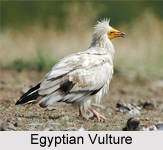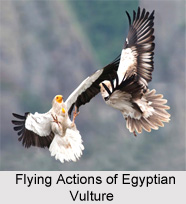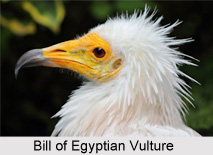 Egyptian Vultures are widely distributed across the Old World with their breeding range from southern Europe to northern Africa east to western and southern Asia. They are rare vagrants in Sri Lanka and the Indian states.
Egyptian Vultures are widely distributed across the Old World with their breeding range from southern Europe to northern Africa east to western and southern Asia. They are rare vagrants in Sri Lanka and the Indian states.
Concentration of Egyptian Vultures
Egyptian Vultures occur mainly on the dry plains and lower hills. In the Himalayas, they go up to about 2,000 metres in summer. European populations migrate south to Africa in winter. Vagrants may occur as far south as in South Africa although they bred in the Transkei region prior to 1923.
Nests of Egyptian Vultures
Egyptian vultures nest mainly on rocky cliffs, sometimes adopting ledges on tall buildings in cities and on large trees.
Migration of Egyptian Vultures
Most of the Egyptian vultures in the temperate zone migrate south to Africa in winter. Like many other large soaring migrants, they avoid making long crossings over water. Italian birds cross over through Sicily and into Tunisia making short sea crossings by passing through the islands of Marettimo and Pantelleria.  Those that migrate through the Iberian Peninsula cross into Africa over the Strait of Gibraltar while others cross further east through the Levant. The migrating birds can sometimes cover 500 kilometres (310 mi) in a single day until they reach the southern edge of the Sahara, 3,500 to 5,500 kilometres from their summer home. Young birds that have not reached breeding age may over winter in the grassland and semi-desert regions of the Sahel.
Those that migrate through the Iberian Peninsula cross into Africa over the Strait of Gibraltar while others cross further east through the Levant. The migrating birds can sometimes cover 500 kilometres (310 mi) in a single day until they reach the southern edge of the Sahara, 3,500 to 5,500 kilometres from their summer home. Young birds that have not reached breeding age may over winter in the grassland and semi-desert regions of the Sahel.
Behaviour of Egyptian Vultures
Egyptian vulture is usually seen singly or in pairs, soaring in thermals along with other scavengers and birds of prey, or perched on the ground or atop a building. On the ground, they walk with a waddling gait. They feed on a range of food, including mammal faeces insects in dung, carrion, vegetable matter, and sometimes small animals. When it joins other vulture species at a dead animal, it tends to stay on the periphery and waits until the larger species leave. Wild rabbits form a significant part of the diet of Spanish vultures. Studies suggest that they feed on ungulate faeces to obtain carotenoid pigments responsible for their bright yellow and orange facial skin. The ability to assimilate carotenoid pigments may serve as a reliable signal of fitness.
Sounds of Egyptian Vultures
Egyptian Vultures are mostly silent but make high-pitched mewing or hissing notes at the nest and screeching noises when squabbling at a carcass. The young Egyptian vultures have been heard making a hissing croak in flight. They also hiss or growl when threatened or angry.
Society of Egyptian Vulture
Egyptian Vultures roost communally on large trees, buildings or on cliffs. Roost sites are usually chosen close to a dump site or other suitable foraging area. In Spain, summer roosts are formed mainly by immature birds. The favourite roost trees tended to be large dead pines. The number of adults at the roost increases towards June. It is thought that breeding adults may be able to forage more efficiently by joining the roost and following others to the best feeding areas. Breeding birds that failed to raise young may also join the non-breeding birds at the roost during June.
Breeding of Egyptian Vulture
The breeding season of Egyptian Vultures is in spring. During the beginning of the breeding season, courting pairs soar high together and one or both may make steep spiralling or swooping dives. The birds are monogamous and pair bonds may be maintained for more than one breeding season and the same nest sites may be reused each year.



















